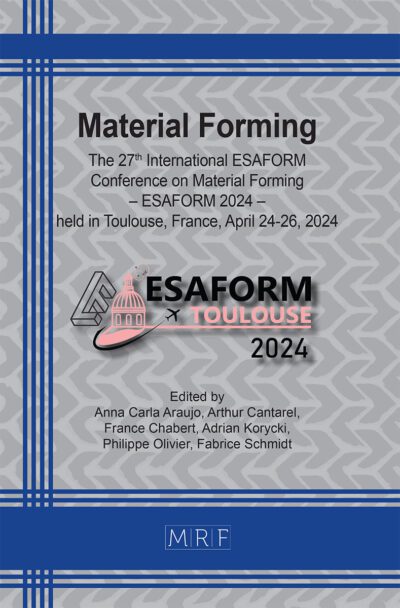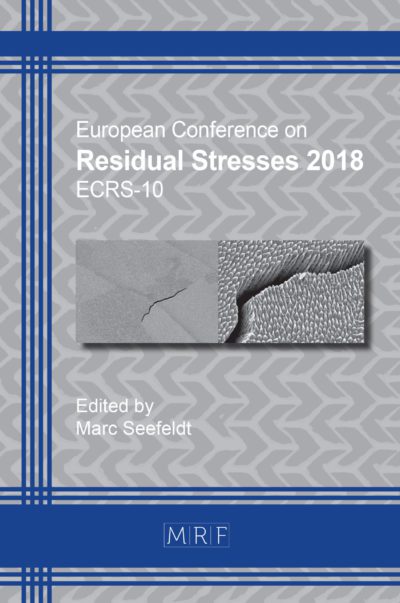Finish milling of polylactide (PLA) 3D-printed parts: Influence of printing pattern and lubrication on final surface roughness
Margaux LORENZONI, Laurent SPITAELS, Edouard RIVIERE-LORPHEVRE, Jérémy ODENT, Rachid M’SAOUBI, Liam CLOËZ, Michaël FONTAINE, François DUCOBU
Abstract. Fused Filament Fabrication (FFF) is an additive manufacturing (AM) process bringing many advantages over conventional processes such as allowing to obtain complex geometries and personalized designs at a lower cost. However, this process does not allow to reach tight surface roughness nor dimensional tolerances. To overcome these limits, post-production finishing techniques are required, such as finish milling. Yet, due to their intrinsic properties, thermoplastics tend to melt and form burr during cutting preventing the reach of fine surface quality. Therefore, this paper proves the relevance and necessity of using lubrication and shortening the machining time to reduce burr formation and allow to reach better final surface roughness.
Keywords
Polylactide, PLA, Additive Manufacturing, Milling, Finishing, Printing Pattern, Surface Roughness
Published online 5/7/2025, 10 pages
Copyright © 2025 by the author(s)
Published under license by Materials Research Forum LLC., Millersville PA, USA
Citation: Margaux LORENZONI, Laurent SPITAELS, Edouard RIVIERE-LORPHEVRE, Jérémy ODENT, Rachid M’SAOUBI, Liam CLOËZ, Michaël FONTAINE, François DUCOBU, Finish milling of polylactide (PLA) 3D-printed parts: Influence of printing pattern and lubrication on final surface roughness, Materials Research Proceedings, Vol. 54, pp 1747-1756, 2025
DOI: https://doi.org/10.21741/9781644903599-188
The article was published as article 188 of the book Material Forming
![]() Content from this work may be used under the terms of the Creative Commons Attribution 3.0 license. Any further distribution of this work must maintain attribution to the author(s) and the title of the work, journal citation and DOI.
Content from this work may be used under the terms of the Creative Commons Attribution 3.0 license. Any further distribution of this work must maintain attribution to the author(s) and the title of the work, journal citation and DOI.
References
[1] Pei E, Bernard A, Gu D, Klahn C, Monzón M, Petersen M, et al., editors. Springer Handbook of Additive Manufacturing. Cham: Springer International Publishing; 2023. https://doi.org/10.1007/978-3-031-20752-5
[2] Gibson I, Rosen D, Stucker B, Khorasani M. Additive Manufacturing Technologies. Cham: Springer International Publishing; 2021. https://doi.org/10.1007/978-3-030-56127-7
[3] Lalegani Dezaki M, Mohd Ariffin MKA, Ismail MIS. Effects of CNC Machining on Surface Roughness in Fused Deposition Modelling (FDM) Products. Materials 2020;13:2608. https://doi.org/10.3390/ma13112608
[4] Vyavahare S, Teraiya S, Panghal D, Kumar S. Fused deposition modelling: a review. Rapid Prototyp J 2019;26:176–201. https://doi.org/10.1108/RPJ-04-2019-0106
[5] Mertkan İA, Tezel T, Kovan V. Improving surface and dimensional quality with an additive manufacturing-based hybrid technique. Int J Adv Manuf Technol 2023;128:1957–63. https://doi.org/10.1007/s00170-023-12055-z
[6] Susanto B, Rashyid MI, Tanbar F, Ariyadi HM, Muflikhun MA. Surface roughness and dimension accuracy data from hybrid manufacturing process using PLA material. Data Brief 2024;54:110477. https://doi.org/10.1016/j.dib.2024.110477
[7] Lee J, Song J, Lee YC, Kim JT. Development of a huge hybrid 3D-printer based on fused deposition modeling (FDM) incorporated with computer numerical control (CNC) machining for industrial applications. High Temp Mater Process 2022;41:123–31. https://doi.org/10.1515/htmp-2022-0018
[8] Grguraš D, Kramar D. Optimization of Hybrid Manufacturing for Surface Quality, Material Consumption and Productivity Improvement. Stroj Vestn – J Mech Eng 2017;63:567–76. https://doi.org/10.5545/sv-jme.2017.4396
[9] Kalia S, Avérous L. Biodegradable and Biobased Polymers for Environmental and Biomedical Applications. John Wiley & Sons; 2016.
[10] Li Y, Wang S, Qian S, Liu Z, Weng Y, Zhang Y. Depolymerization and Re/Upcycling of Biodegradable PLA Plastics. ACS Omega 2024;9:13509–21. https://doi.org/10.1021/acsomega.3c08674
[11] Bhattacharya M, Reis RL, Correlo V, Boesel L. Material properties of biodegradable polymers. Biodegrad. Polym. Ind. Appl., Elsevier; 2005, p. 336–56. https://doi.org/10.1533/9781845690762.3.336
[12] Lalegani Dezaki M, Mohd Ariffin MKA, Baharuddin BTHT. Experimental Study of Drilling 3D Printed Polylactic Acid (PLA) in FDM Process. In: Dave HK, Davim JP, editors. Fused Depos. Model. Based 3D Print., Cham: Springer International Publishing; 2021, p. 85–106. https://doi.org/10.1007/978-3-030-68024-4_5
[13] Cloëz L, Fontaine M, Gilbin A, Barrière T. Machinability of PLA obtained by injection molding under a dry milling process, 2024, p. 1877–86. https://doi.org/10.21741/9781644903131-208
[14] Lalegani Dezaki M, Mohd Ariffin MKA. Post-processing of FDM 3D-Printed Polylactic Acid Parts by CNC Trimming. In: Dave HK, Davim JP, editors. Fused Depos. Model. Based 3D Print., Cham: Springer International Publishing; 2021, p. 195–212. https://doi.org/10.1007/978-3-030-68024-4_11
[15] Mehtedi ME, Buonadonna P, Carta M, Mohtadi RE, Marongiu G, Loi G, et al. Effects of milling parameters on roughness and burr formation in 3D- printed PLA components. Procedia Comput Sci 2023;217:1560–9. https://doi.org/10.1016/j.procs.2022.12.356
[16] Kartal F, Kaptan A. EXPERIMENTAL DETERMINATION OF THE OPTIMUM CUTTING TOOL FOR CNC MILLING OF 3D PRINTED PLA PARTS. Int J 3D Print Technol Digit Ind 2023;7:150–60. https://doi.org/10.46519/ij3dptdi.1267634
[17] Pămărac RG, Petruse RE. Study Regarding the Optimal Milling Parameters for Finishing 3D Printed Parts from ABS and PLA Materials. Acta Univ Cibiniensis Tech Ser 2018;70:66–72.
[18] Dilberoglu UM, Yaman U, Dolen M. A comprehensive guide to milling techniques for smoothing the surfaces of 3D-printed thermoplastic parts. Rapid Prototyp J 2024;30:1648–62. https://doi.org/10.1108/RPJ-08-2023-0277
[19] Zmeskal O, Marackova L, Lapcikova T, Mencik P, Prikryl R. Thermal properties of samples prepared from polylactic acid by 3D printing. AIP Conf Proc 2020;2305:020022. https://doi.org/10.1063/5.0033857
[20] Zhang A, Li Y. Thermal Conductivity of Aluminum Alloys—A Review. Materials 2023;16:2972. https://doi.org/10.3390/ma16082972
[21] Dessarthe A. Usinage des polymères. Tech Ing 2000. https://doi.org/10.51257/a-v1-bm7426.
[22] Nanovia. Nanovia PLA EF 3D850 : Sans perturbateur endocrinien : Nanovia. Nanovia – Compos Mater Adv Ind n.d. https://nanovia.tech/en/ref/pla-ef/ (accessed June 10, 2024).
[23] Boschetto A, Bottini L, Veniali F. Finishing of Fused Deposition Modeling parts by CNC machining. Robot Comput-Integr Manuf 2016;41:92–101. https://doi.org/10.1016/j.rcim.2016.03.004
[24] International Organization for Standardization. Tool life testing in milling – Part 2: End milling 1989.
[25] International Organization for Standardization. Geometrical Product Specifications (GPS) – Surface texture : Profile method – Rules and procedures for the assessment of surface texture 1997.
[26] Ferraris E, Zhang J, Van Hooreweder B. Thermography based in-process monitoring of Fused Filament Fabrication of polymeric parts. CIRP Ann 2019;68:213–6. https://doi.org/10.1016/j.cirp.2019.04.123
[27] Penu C, Helou M. Acide polylactique (PLA). Tech Ing 2017. https://doi.org/10.51257/a-v1-am3317
[28] International Organization for Standardization. Geometrical Product Specifications (GPS) – Indication of surface texture in technical product documentation 2002.














